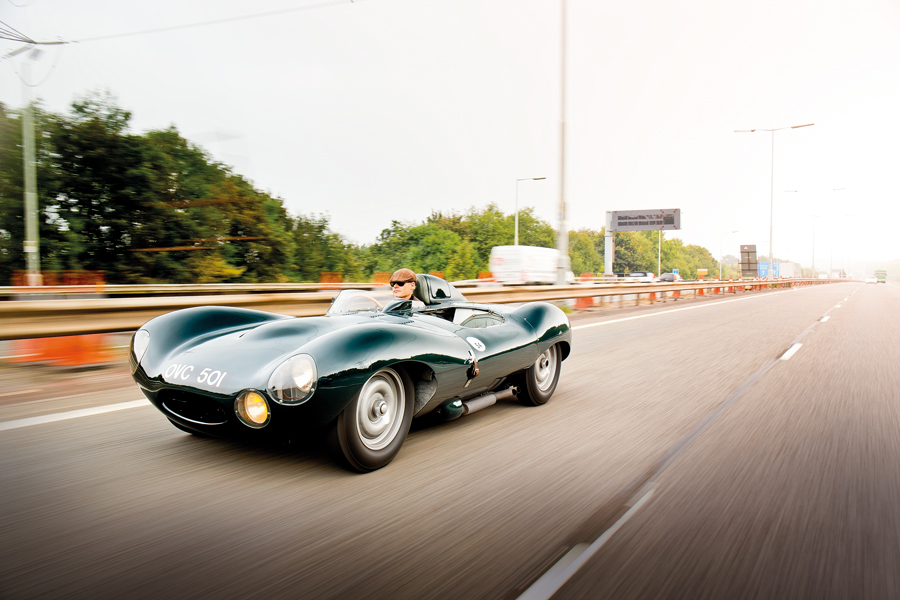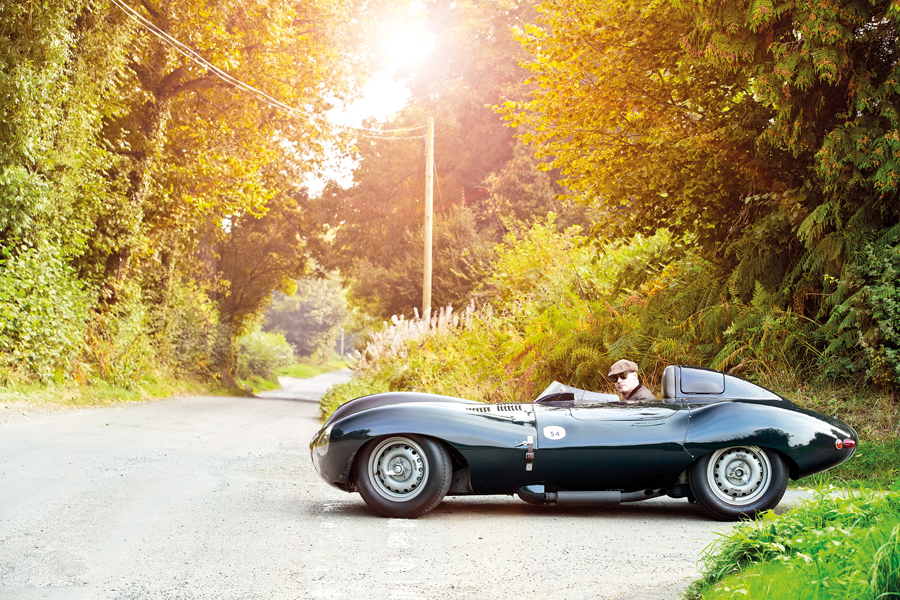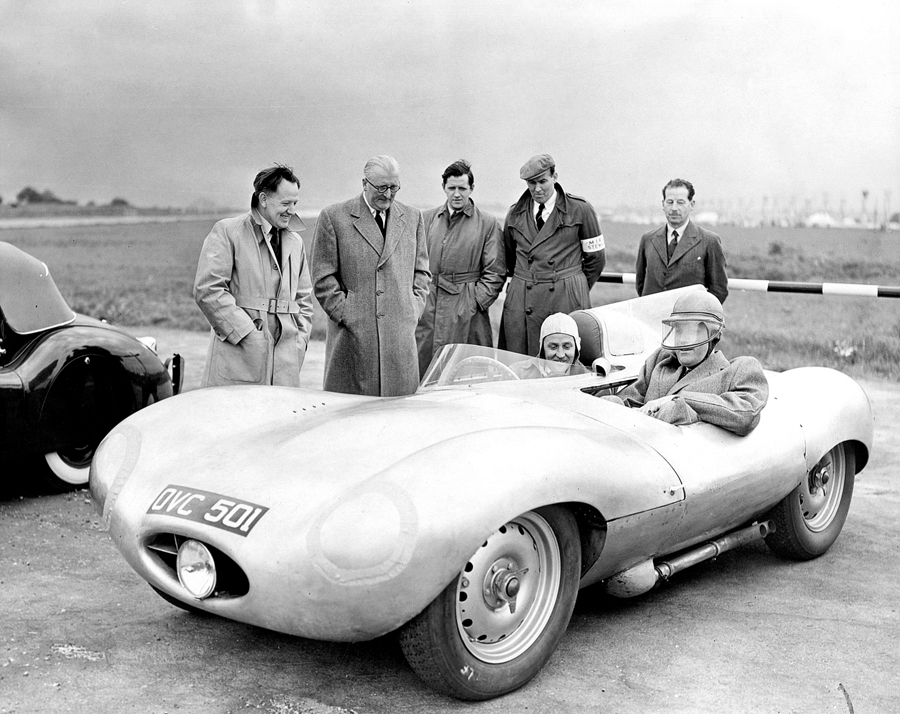The D-type is 60 years old this year – so how better to celebrate than to drive the original prototype to meet the man who developed it, legendary tester Norman Dewis
Words: Mark Dixon, Photography: Matthew Howell.
Filed under: FEATURES
Coventry is not what most people would consider a romantic city. It doesn't have medieval colonnades, or huge Royal parks, or a majestic river flowing through its centre. What it does have is an awful lot of concrete, the legacy of a joint effort by the Luftwaffe in World War Two and the city's planners a few years later.
 But if you like cars, then Coventry is one of the most evocative places in the world. It's a city founded on the motor car, at various times the home of well over 100 separate marques. The place is in a state of constant flux but, as you sweep around one of the smoothly curving elevated sections of the inner ring road between low-rise tower blocks, it's easy to understand the utopian dream those city fathers had in the go-ahead years of the '50s and '60s.
But if you like cars, then Coventry is one of the most evocative places in the world. It's a city founded on the motor car, at various times the home of well over 100 separate marques. The place is in a state of constant flux but, as you sweep around one of the smoothly curving elevated sections of the inner ring road between low-rise tower blocks, it's easy to understand the utopian dream those city fathers had in the go-ahead years of the '50s and '60s.
To really appreciate the town's history, though, you should be driving a Jaguar, Coventry's most iconic product after, perhaps, Lady Godiva. And if it's a Jaguar D-type… well, then, the sensory overload is complete. The ring road may not have much in the way of pretty scenery, but those monochrome concrete walls do a damn fine job of bouncing back the sound of a 1950s Le Mans race engine.
The D-type was the archetypal developed-on-a-shoestring worldbeater, the car that added another clutch of Le Mans victories to the pair already scored by the C-type. The car in our pictures is the factory prototype, chassis XKC 401, that 'C' in the chassis number a giveaway that no-one had decided on the new car's title at the time it was constructed. A conservative estimate of its value in today's market would be £7-10 million – and Octane is about to drive it through Coventry's rush hour and along the M6 motorway, one of Britain's busiest. We're very glad, and extremely grateful, that Jaguar is picking up the tab for the insurance...
The reason for our Midlands road trip is that, incredibly, amazingly, the man who helped develop this car and who put many thousands of miles on it during the mid-1950s is still as hale and hearty as the car itself. That man is, of course, the legendary Norman Dewis, Jaguar's chief development engineer during its glory years with the C-, D- and E-types. He recently turned 94 years old but looks like a man 20 years younger – and behaves like one considerably younger than that. (He's an outrageous flirt, but so charming that he gets away with it every time.)
Norman has lived in Shropshire since retiring from Jaguar in 1985 – although, such is his demand on the Jaguar scene, he's away attending events as much as he's at home, and we caught him just before he jetted off to Arizona for the annual C- and D-type tour –and the journey from Coventry promises an intriguing mix of city driving, fast dual-carriageway and motorways, and gorgeous rural byways. All in a proper Le Mans car. Let's hope it doesn't rain.
Photographer Matt Howell and I rendezvous at Jaguar's Whitley plant in Coventry, where the statue of Sir William Lyons – pictured above – outside the entrance to the Engineering Centre seems an appropriate departure point. The sight of OVC 501 basking beneath Sir Williams' benevolent gaze draws sharp-suited office workers like a magnet; many of them may not have a clue about the car or its significance, but they can appreciate the sheer sexiness of its Malcolm Sayer-penned curves. With its short, pugnacious nose, the car looks compact and muscular, every inch the racer.
'Have you ever driven a D-type?' asks Dave, our cheery technician from Jaguar Heritage, just like the greeter at a Harvester restaurant. 'Not recently…' I reply. 'Well, the clutch is race spec and if you're careless with the throttle it will flood the carbs and the engine will bog down,' he advises helpfully, before shutting the wafer-thin driver's door and enclosing me in what feels like a Victorian hip bath. Now all I have to do is pull away from the throng of bystanders without stalling, and drive straight into the maelstrom of 21st-century Coventry traffic. What could possibly go wrong?
+10
Not much, is the honest answer, because the D-type proves to be one of those cars that is instantly on your side. Waggle the heavily cranked-forward gearlever to check that it's in neutral, heave down on the clutch pedal, give the throttle just an inch or two of gas and thumb the starter: the Jaguar fires without hesitation, exhaust note ripping as the revcounter needle leaps in surprise.
OK, so the clutch is a little sharp, but it's not too difficult; modulating the throttle to avoid the fluffing that Dave has warned me about takes a little getting used to, but hey, it's a welcome excuse to keep the revs up and let the straight-six sing. The side-exit exhaust issues a crisp snort, which is not as obtrusive as you might think; at urban speeds it snarls pleasantly but not so loudly as to annoy the locals. Any chavved-up Vauxhall Corsa would worry a decibel-meter more.
This getting-to-know you phase is always critical, and not least when you're threading a £10-million piece of alloy-bodied art through unforgiving city streets. Fortunately, the D is small enough that you feel you could almost lean out and touch – 'stroke' might be a more appropriate word – the voluptuous swell of each front wing and, because this car lacks the rear fin usually associated with D-types (they were riveted on for Le Mans in 1954), rearwards vision isn't bad at all.
Confidence grows quickly as you learn to appreciate the beautifully fluid and accurate steering, which is helped by the car's light weight – at round about 870kg dry, a D-type is only slightly heavier than my tiny, three-cylinder Mk1 Honda Insight. And the brakes are perfect: there's no lost travel, just an instant and progressive bite that means, after the first tentative application, you simply forget about them. That's in normal road driving, mind you – as you'll read later, in Richard Meaden's account of racing a D-type at Le Mans Classic (pages 64-70), opinions may change when you're braking from 140mph for a chicane on the Mulsanne...
 Richard describes how the cockpit of a 'D' really does feel like something aeronautical, with the exposed rivets and bare aluminium, and it's a simile that strikes every first-time D-type driver; the folded-up sheets of alloy, the cluster of no-nonsense, black-faced instruments and matt-black paint is very WW2 fighter. But that's not so surprising, given that XKC 401 was built only nine years after the end of the war.
Richard describes how the cockpit of a 'D' really does feel like something aeronautical, with the exposed rivets and bare aluminium, and it's a simile that strikes every first-time D-type driver; the folded-up sheets of alloy, the cluster of no-nonsense, black-faced instruments and matt-black paint is very WW2 fighter. But that's not so surprising, given that XKC 401 was built only nine years after the end of the war.
While the C-type and D-type's works competition careers were contained within much less than a single decade, they were poles apart in design and capabilities. The C-type effectively had a spaceframe chassis while the D used a monocoque central tub with front subframe welded to it; the C ran on old-fashioned wire wheels whereas the D had the latest Dunlop alloys; and the engine, while carried over from the C with minimal top-end changes (bigger inlet valves, different camshaft), was dry-sumped in the D.
Besides obviating problems of oil surge in corners, this had the advantage of allowing the big straight-six to sit a full 2¾in lower in the chassis than it had in the C – and that meant Sayer could devise a lower, sleeker design. In terms of outright sexuality, the C was a Celia Johnson compared with the D's Diana Dors.
This car, chassis XKC 401, was completed in about March 1954 and was quickly followed by the three works entries for Le Mans, chassis 402-404 respectively. XKC 401 was registered as OVC 501, while 402-404 became OKV 1, 2 and 3. Jaguar entered a crack team of drivers for the Le Mans debut of the works D-types – Hamilton, Rolt, Moss, Walker, Whitehead and Wharton – but mechanical troubles gave a narrow victory to Gonzales in his 4.9-litre Ferrari. Duncan Hamilton later recalled that, as he desperately tried to reel in Gonzales on a wet track, '...I realised I was getting wheelspin at 170mph in top gear.' He did the sensible thing and backed off slightly, to ensure a podium place for Jaguar.
D-type results were mixed over the next 12 months – respectable, but nothing outstanding – and the design was quickly developed ahead of 1955's Le Mans. Biggest change was that the front subframe was now bolted rather than welded to the front bulkhead, which made running repairs much quicker, and its tubes were of nickel-steel rather than magnesium alloy – yet the tubes were lighter, because they could be made thinner. More obviously, the noses of the 1955 works team cars were made 7½in longer, in the constant quest for better aerodynamics and higher top speed. About 30bhp more was extracted from the 1955-spec engines by, among other things, enlarging the inlet and exhaust valves to release 270bhp.
That year's Le Mans would, of course, become infamous for the dreadful tragedy in which scores of people were killed when Pierre Levegh's Mercedes rocketed into the crowd. Mercedes, which had been leading the race, withdrew its team after the accident, ceding a rather hollow victory to Hawthorn and Bueb in works D-type XKD 505 – although it is arguable that they were on track to beat the Fangio/Moss 300SLR anyway.
For Le Mans in 1956, two of the three works D-types were equipped with Lucas fuel injection. The race, however, did not go well for the Jaguar team, and all three cars retired due to accidents or, in the case of Hawthorn's injected car, XKD 605, a hairline crack in a fuel line. It was Ecurie Ecosse's entry that saved the day, when Flockhart and Sanderson gave the D-type its second Le Mans victory.
+10
Ecurie Ecosse repeated the trick in 1957, bringing its cars home both first and second (five of the top six finishers were D-types), but Jaguar had abandoned motor sport long before then to concentrate on what would become the E-type – a decision reinforced by the factory fire of February 1957, which wiped out nine D-types that were 'in build' from the 67 chassis laid down in 1955-56. Forty-two Ds were sold, and 16 were turned into the more road-oriented XKSS model in an attempt to boost declining sales. The D-type's day was done.
Crackling along the motorway in a D-type, revcounter pulling a modest 3400rpm, is a surreal experience, like being timewarped forwards six decades from La Sarthe. My shades and flat cap may look like affectations but they work remarkably well at keeping eyes clear and head warm as the airflow is deflected effectively over the shallow 'screen. The engine does a fine job of heating the cabin, too – every press of the throttle seems to release a burst of hot air around your legs.
The rpm figure is significant because it's at this point that the D starts to morph into its true nature of a high-speed racer, the exhaust note sharpening and intensifying as if the car is awaking from a doze. Two years ago, I rode shotgun with Le Mans winner Andy Wallace in a D-type to Geneva; he couldn't resist gunning the engine through every tunnel for the sheer joy of hearing that noise. And this is a man who tests Bugatti Veyrons for a living.
Sadly, there are no tunnels on my route to Shropshire, and after a heavily trafficked spell of A-road I arrive at Norman's house – where the huge Jaguar 'growler' stencilled on his garage door is a bit of a giveaway. There's nowhere to park off the road so I abandon the D-type half on the pavement, trying not to remember that it is worth the same as most of the houses on this street put together. It's what they would have done in the '50s, I tell myself. Norman puts the kettle on and we start chatting about the D-type. It's a car he knows very well indeed.
'It was the prototype, so I put thousands of miles on it driving to MIRA [the Motor Industry Research Association's proving ground at Nuneaton, north of Coventry] and testing it there. It was in bare metal, for there was no time to paint it! I've never worked out exactly how many miles I covered in it but my old logbooks are in the attic, so one day I'll have to sit down and go through them – when I have some free time, that is...
 'When I was brought into the C-type programme a few years earlier, I was very unhappy about its weight distribution, because the huge rear-mounted tank could give terrible oversteer. So my priority was to improve that for the new car. It wasn't called a D-type then but we coined the name in the Experimental shop because it just seemed logical to do so.
'When I was brought into the C-type programme a few years earlier, I was very unhappy about its weight distribution, because the huge rear-mounted tank could give terrible oversteer. So my priority was to improve that for the new car. It wasn't called a D-type then but we coined the name in the Experimental shop because it just seemed logical to do so.
'The most dramatic moment I had in a D-type was, I think, in this actual car. Daimler was building the glassfibre SP250 sports car and Bill Heynes [Jaguar's chief engineer] thought we should investigate the possibility of using a glassfibre bonnet on the D. So they made one and I went off to MIRA to test it.
'At the same time, I was also testing modifications to the gearbox, which involved driving at maximum revs on the high-speed banking for a couple of hours to ensure that everything got really hot. As I came down off the banking onto the Railway Straight, the 'box seized up and sent me onto the infield, where the car rolled over with me trapped underneath it. Fortunately, McAlpine's were resurfacing the no 2 circuit, and two big Irish lads rushed over to help. All I heard was: "Are you alroight under there, Sorr?", to which I replied: "No I'm bloody not!"
'They lifted the car enough for me to crawl out, and later that evening I bought them as much Guinness as they could drink. The postscript to this story is that I took a piece of the broken glassfibre bonnet back to Heynes, presented it to him and said: "There you are – I've tested it!"
'We did things very differently to the way most companies worked. We'd go to MIRA where our brilliant body man Bob Blake, who was ex-Briggs Cunningham, would fashion a scoop or whatever we decided was needed, we'd rivet it on the car, test it, and then give it to the drawing office. It was the quickest way.'
I could happily sit and listen to Norman reminisce all day, but there are pictures to shoot, and locations to find, and miles to go before we sleep...
Turn right out of Norman's street and you'll find yourself on the B4371, the classic rolling English road made by the rolling English drunkard, and a perfect playground for the D-type – although there's hardly a chance to do more than scratch the surface of this car's performance. Being an early example, it has 'only' 245bhp but, with so little weight to propel, it feels genuinely, seriously fast. It's not just 'quick for its age'. It's quick, full stop.
Although the D-type was developed for big, fast circuits, the ride quality is astonishingly good. All the dynamic bits – steering, suspension, brakes – work so well together that you feel you are dancing with the car in a piece of extemporised choreography, the D reacting to your moves like a partner who instinctively knows which way to go. It rewards precision and it thrills in much the same way that Supermarine Spitfires must have exhilarated the young pilots who first experienced them just 15 years before this car was built. Coincidentally, the last operational sortie of an RAF Spitfire took place within a few days of XKC 401 being completed.
Back at Norman's place, there's time for one last cup of tea before 'his' D-type is returned to base in Coventry. With the benefit of hindsight, I ask him, is there anything he wishes they'd done differently, back in the day? He thinks for a moment. 'Not really,' he concludes. 'The D-type was just right, from the beginning.'